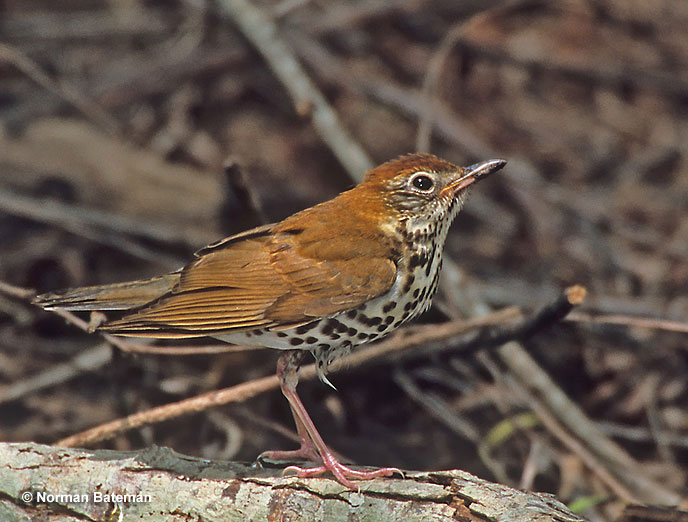The Wood Thrush has reddish-brown upperparts and dark spots on white underparts.
If you hear a bird singing a beautiful, flute-like song in deciduous forest, you may have found a Wood Thrush. Watch for this shy bird foraging on the ground along forest trails in the early morning and late afternoon.
On this page
Identification
The Wood Thrush is a small to medium-sized songbird with black spotting on white underparts. A bit smaller than a Northern Cardinal, it is 7.75 inches long, has a wingspan of 13 inches, and weighs 1.6 ounces.
Male and female Wood Thrushes look the same. They have reddish-brown upperparts with brighter plumage on their crown and the back of their neck. These birds also have fine black markings on their face, a white eyering, and a white “moustache” mark.
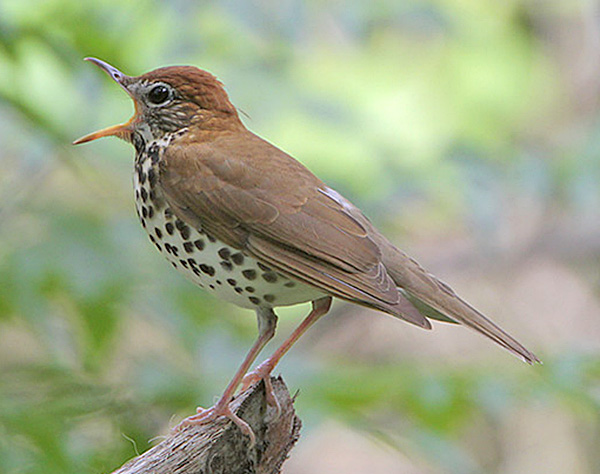
The Wood Thrush has an average-sized, dark beak with grayish-pink on the base of the bill, some brown on its lower flanks, and long, pink legs.
They have long wings with a buff mark on the underside of each wing, and a white undertail that extends about halfway down the underside of their medium length, slightly rounded tail.
Vocalization
The beautiful song of the Wood Thrush is only given by the male in spring and summer. He usually sings in the early morning and in the late afternoon from a fairly high perch.
The song sounds has three distinct phrases, each a little higher in pitch than the last. It sounds like, “tuktuk EOO LAYOO Teeee!”.
They also make a few staccato notes, “wik wik wik wik”.
Food
The Wood Thrush has a diet of insects, other invertebrates, and fruit. On their breeding grounds, these birds eat small creatures like spiders, millipedes, beetles, and other insects that they find on the ground.
During migration and winter, they still catch invertebrates but also eat berries and other small fruits.
They take fruit from a number of species, but some of the more commonly eaten fruits are from Spicebush, Blueberry, Fox Grape, Virginia Creeper, Pokeweed, and Dogwood.
Planting any of these and other native plants that produce berries can provide important food for the Wood Thrush and other migrant birds.
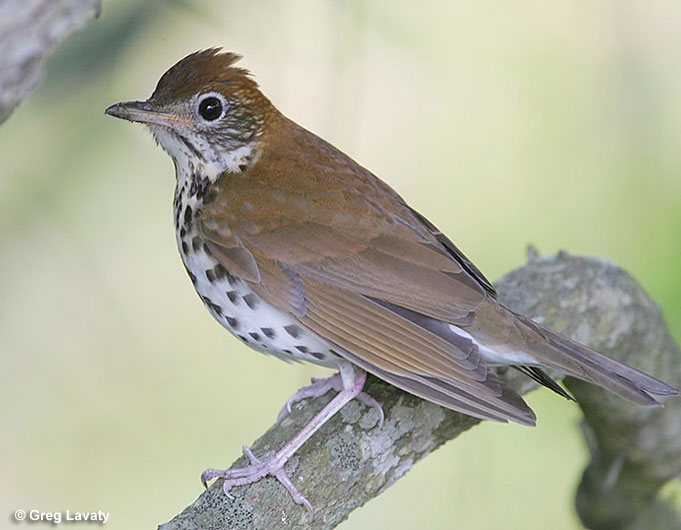
On their wintering grounds, they also eat a wide variety of fruit along with small creatures that live in the leaf litter of tropical forest.
Wood Thrushes search for invertebrates a lot like an American Robin but only forage in shaded, forested habitats. They carefully hop along the forest floor and watch for small creatures. When they see potential food, they quickly move in to pick it up from the ground.
These birds also use their beaks to move leaves and reveal hidden insects. When feeding on fruit, they usually pick berries while perched in a tree or bush.
Nesting and Eggs
The Wood Thrush uses grass, rootlets, leaves, and other bits of vegetation to make a cup nest in the fork of a branch.
The female does most of the nest building and uses mud to help mold it together. She usually constructs her nest in a deciduous tree around 14 feet above the ground. It can be fairly well hidden or readily visible.
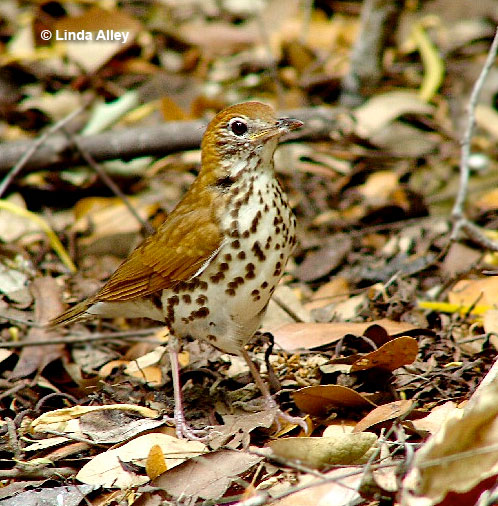
Once the nest is finished, the female lays three to four gray-green eggs that are one inch long and weigh 0.16 ounces. She incubates them for around 12 days.
Shortly after hatching, both parents bring soft food to the nestlings and work hard to feed them.
To make sure the young birds grow quickly, their parents feed them throughout the day. They start from just before sunrise and finish just after sunset!
Around two weeks after hatching, the baby birds try to flutter from the nest to nearby branches.
If they fall to the ground, they quickly move up and into branches or other vegetation.
Both parents continue to feed them for at least one more week and sometimes longer.
Shortly after the baby Wood Thrushes become independent, the adult birds usually nest again and raise a second brood.
Current Situation
The Wood Thrush is a summer resident in southeastern Canada, and much of the eastern USA. It occurs in deciduous woodlands and has a preference for larger areas of mature forest.
This species winters in tropical forest habitats in southern Mexico and Central America.
The Wood Thrush is listed as Least Concern in the IUCN Red List.
Although this species is still fairly common and is not considered endangered, there have been worrisome declines in its population. From 1966 to 2019, the number of Wood Thrushes declined by 50%.
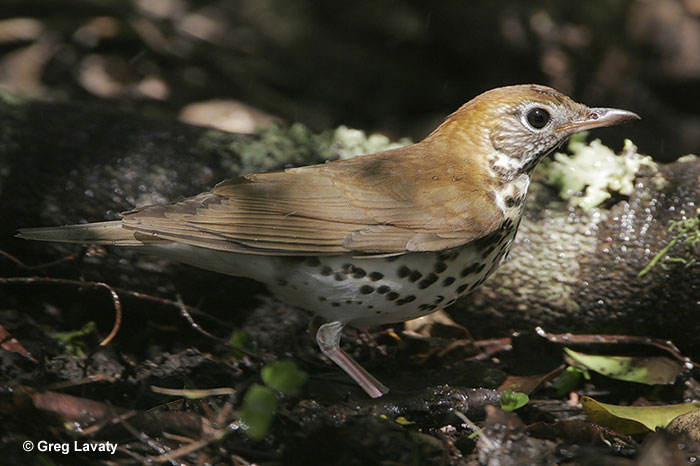
This decline is believed to be related to a combination of factors but mostly habitat loss on their wintering grounds and forest fragmentation on their breeding grounds.
As forests become more fragmented, Wood Thrush nests can be more susceptible to nest predators like Raccoons.
They might also be affected by acid rain and pesticide use. If the Wood Thrush continues to decline, it could eventually become threatened with extinction.
Facts
- Male Wood Thrushes feed the first brood of nestlings more than the female does. They do this so the mother bird can have time to lay a second clutch of eggs.
- Before breeding, female Wood Thrushes eat a lot of snails to get calcium needed for their eggs.
- Just as with their breeding grounds, Wood Thrushes defend a territory on their wintering grounds. Since they usually come back to the same spot inside tropical forest, they are very susceptible to deforestation in Mexico and Central America.
- This species is the official bird species for Washington D.C. It earned this status in 1938 because its beautiful song was commonly heard during summers in Rock Creek Park, and other woodlands in the District.
- The Wood Thrush has also been known as the Wood Robin, Song Thrush, and Swamp Angel. All of these names refer to its preference for mature, shaded forests, and its lovely song.
Similar Species
The Wood Thrush has some good field marks to separate it from other species. However, it does look similar to a few other thrush species.
Swainson’s Thrush
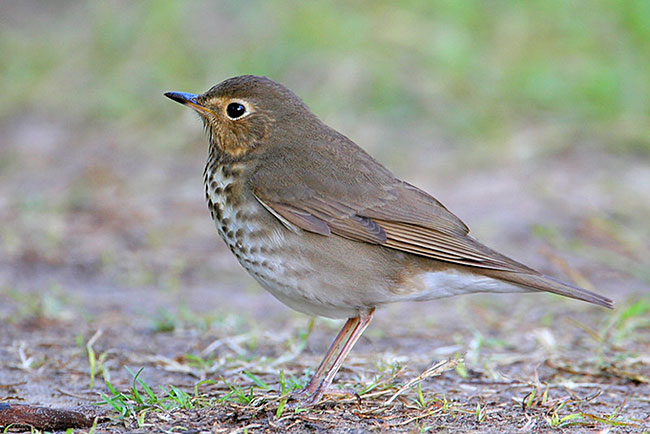
The Swainson’s Thrush is somewhat similar to the Wood Thrush but has a buff eyering instead of a white one, and lacks black on its face.
It is more olive-brown above, and the spotting on its underparts are not nearly as bold or extensive as the Wood Thrush.
Veery
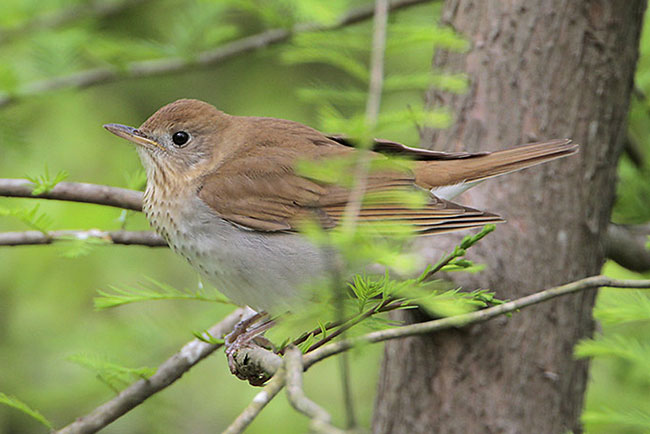
The Veery has similar reddish-brown coloration on its upperparts but is a much plainer bird. It only has some faint, pale brown spotting on its chest, and has a gray-brown face.
Hermit Thrush
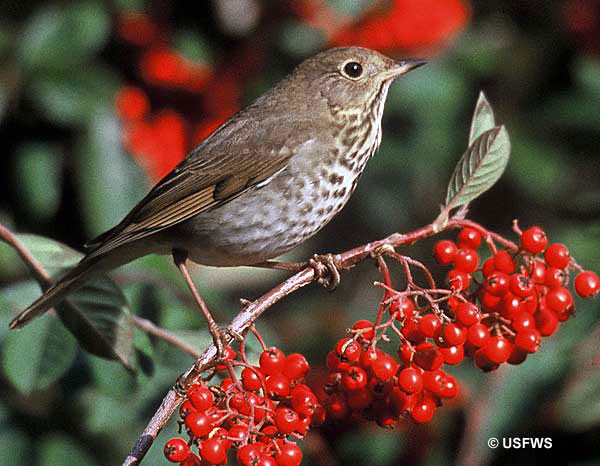
Hermit Thrush is another thrush that also forages on the ground in wooded habitats. However, is more olive-brown above than reddish-brown, lacks black on its face, and has a contrasting, reddish-brown tail.
Frequently Asked Questions
What is the difference between a Brown Thrasher and Wood Thrush?
The difference between a Brown Thrasher and Wood Thrush is that the thrasher is a larger bird of brushy habitats with a longer tail, dark streaking on its underparts, and two pale wing bars. The Wood Thrush has black spotting below, lacks wing bars, and lives inside the forest.
Are Wood Thrushes rare?
No, Wood Thrushes are not rare. They are fairly common birds in woodlands throughout their range. However, since their population has declined, they have disappeared from some small wooded parks and other areas.
What are other names for Wood Thrush?
Other names for Wood Thrush are Wood Robin, Swamp Angel, and Song Thrush.
What does a Wood Thrush like to eat?
A Wood Thrush likes to eat beetles, millipedes, worms, and other invertebrates that live in forest soil and leaf litter.
Where do Wood Thrushes go in the winter?
Wood Thrushes go to tropical forests in southern Mexico and Central America for the winter.

